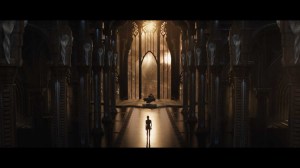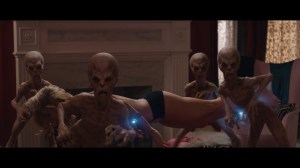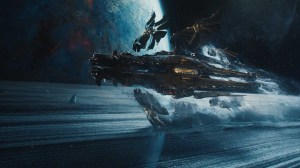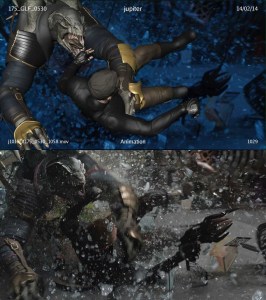
Framestore got involved in pre-production, with a team of animators spending six months carrying out animation tests to help the directors plan the sequences and develop the alien characters.
First there are the Keepers. Creepy by design, they are a group of slinking aliens able to cloak themselves from sight. “They appear in a number of really nightmarish scenes and work more as creatures of the night than traditional aliens, so we gave them reversible knees and elbows, which made them quite insect like,” explained animation supervisor Max Solomon.
 The Sargorns were a different prospect. Powerful and capable of speech, the winged reptiles provided an animation challenge as they flicked between calm conversations with humans and moments of bestial rage. Their long, lizard skulls made dialogue interesting, especially as their teeth are fused to their lips. “We had to find the right balance of flexibility within the constraints of that, so we made them talk out of the side of their mouths where there are fewer teeth,” Solomon said. Once they entered fight mode, the emphasis was on making them as animalistic as possible, moving on all fours and using their tails or beating their huge leathery wings. An impressive fight takes place between Tatum’s character and a Sargorn in a boardroom, a huge digital environment constructed by Framestore. Below the cavernous, gilded hall of the boardroom is another Framestore environment, a gruesome DNA laboratory revealed through the floor, which can be made transparent in an instant.
The Sargorns were a different prospect. Powerful and capable of speech, the winged reptiles provided an animation challenge as they flicked between calm conversations with humans and moments of bestial rage. Their long, lizard skulls made dialogue interesting, especially as their teeth are fused to their lips. “We had to find the right balance of flexibility within the constraints of that, so we made them talk out of the side of their mouths where there are fewer teeth,” Solomon said. Once they entered fight mode, the emphasis was on making them as animalistic as possible, moving on all fours and using their tails or beating their huge leathery wings. An impressive fight takes place between Tatum’s character and a Sargorn in a boardroom, a huge digital environment constructed by Framestore. Below the cavernous, gilded hall of the boardroom is another Framestore environment, a gruesome DNA laboratory revealed through the floor, which can be made transparent in an instant.
The fight that rages through these environments is a combination of practical and visual effects, transitioning seamlessly between real-life stunts and full CG shots. Ramps were built in the partial lab set, which allowed Tatum to skate as if he were using jet boots. Framestore then removed the ramps, added Tatum’s boots and animated his pursuer. With the environment built in CG Framestore was able to replace camera moves when necessary and create fully CG shots with a digi-double for any shots that were impossible to film practically, such as when the pair crash through a pane of glass.
 Framestore also created several of Jupiter Ascending’s space ships. The most complex, the Titus Clipper, is introduced with a majestic sweep through the icy rings of a planet. At three kilometers long and consisting of around a billion polygons, it is Framestore’s biggest model so far, a much bigger construct that the International Space Station in Gravity. It is more lavishly detailed than the ISS too, “a floating city with a city’s worth of architecture,” as Montreal VFX supervisor Chris Lawrence put it. “Part of the challenge was giving the model enough richness to sell the scale while still looking functional, a challenge the modellers were very happy trying to solve.”
Framestore also created several of Jupiter Ascending’s space ships. The most complex, the Titus Clipper, is introduced with a majestic sweep through the icy rings of a planet. At three kilometers long and consisting of around a billion polygons, it is Framestore’s biggest model so far, a much bigger construct that the International Space Station in Gravity. It is more lavishly detailed than the ISS too, “a floating city with a city’s worth of architecture,” as Montreal VFX supervisor Chris Lawrence put it. “Part of the challenge was giving the model enough richness to sell the scale while still looking functional, a challenge the modellers were very happy trying to solve.”
The dock the Clipper arrives in is just as grand, a sprawling environment with hundreds of individually places lights and lots of reflective grand architectural detail. A small section of it was shot — a single floor for the actors to walk across — surrounded by greenscreen.
Needing to rescue Jupiter from the Clipper, Tatum and Bean enter an armory, another fully CG environment build, to take a pair of nimble one-man fighter ships called Zeros. The ship protects itself by releasing a shoal of Warhammers – around half a million mines that litter their path to the ship. With so many Warhammers to weave in and out of, and plenty of explosions and debris along the way, there was a lot of emphasis on choreographing the elements in a way that would be easy to follow visually.
 “Making it readable was a big challenge,” said the sequence’s CG supervisor Andy Walker. “It was all about using different colors to contrast different areas of the shot, backlighting it with explosions so you could see the Zeros. We made the Warhammers slowly spin to make them catch the light, which made them less flat. The idea was that they glistened a little bit like shoals of fish. Otherwise they would remain black for much of the shot, either all invisible, or all too visible.”
“Making it readable was a big challenge,” said the sequence’s CG supervisor Andy Walker. “It was all about using different colors to contrast different areas of the shot, backlighting it with explosions so you could see the Zeros. We made the Warhammers slowly spin to make them catch the light, which made them less flat. The idea was that they glistened a little bit like shoals of fish. Otherwise they would remain black for much of the shot, either all invisible, or all too visible.”
Taking the Wachowski’s vision for their sprawling and original universe and helping realize it on the screen produced a multitude of extremely diverse challenges that were equal parts testing and enjoyable. “The variety meant we could never slip into a rhythm but it was also a lot of fun,” said Solomon. “It meant no two sequences were the same, which is also what’s so surprising and appealing about the film.”





